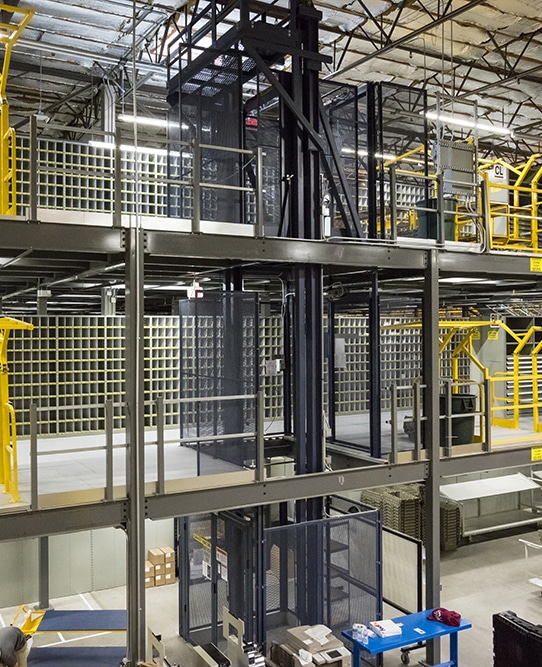“Lift with your knees, not your back.” This is good advice, but in any warehouse, factory, or other work environment where lifting and moving materials is required, however manual material handling is slow, inefficient, and can contribute to increased workplace injuries.
Performing repetitive workplace tasks like bending to lift heavy materials, lifting heavy items overhead, or carrying heavy items up stairs, can lead to injuries that OSHA categorizes as musculoskeletal disorders (MSDs). MSDs can lead to employees spending extended time away from work to recover.

Even if employees don’t develop MSDs, manual material handling can lead to fatigue which contributes to lower productivity and increases the risk of errors and accidents.
Using the right material handling equipment can help streamline your operations and keep workers safe. The following material handling equipment is essential for safe and efficient movement of materials in almost any facility. Let’s take a closer look at each type of equipment.
Forklifts
Forklifts are ideal for lifting and moving pallets throughout your facility, loading and unloading delivery vehicles, and for lifting goods to mezzanines or balconies.
Forklifts have various power sources (electric, liquified petroleum gas / propane gas, gasoline, diesel, or battery) and each have their pros and cons and lifting capacity. Here are some things to consider before purchasing or renting a forklift: 6 Factors to Consider Before Purchasing a Forklift | Industry Today
Sideloaders
A variation of the forklift is the sideloader. A sideloader places the operator’s cab at the front-left side of the vehicle. The area to the right of the cab is called the bed or platform, and contains the forks. Placing the driver's cab on the side of the vehicle reduces the amount of space needed to lift loads onto racking in narrow aisleways. Originally developed for the timber and lumber industries, sideloaders are now essential pieces of equipment in warehouses and applications that require moving long, wide, or heavy loads.
Pallet Jacks or Pallet Trucks
Pallet jacks or pallet trucks allow workers to move single pallets and are perfect for transporting small loads short distances. Pallet jacks are a simplified version of a forklift and one of the most affordable and lowest maintenance ways to move individual pallets around your facility. With the exception of the counterbalanced walkie stacker, pallet jacks typically lift materials only 7”-10” off the ground.
Pallet jacks can be manual or powered. Manual pallet jacks work by lowering the pallet jack’s forks (via lever that is attached to a hydraulic pump), sliding the forks under the pallet, then pumping the pallet jack’s handle to raise the forks and lift the pallet off the ground. The pallet can then be moved to another location. How to Use a Pallet Jack: Step-by-Step Guide | BigRentz
Powered pallet jacks are driven by either battery or electric and the forks are raised and lowered electronically. Other types of powered pallet jacks are:
- Electric Walkie Stackers: Have lifting capacities of 4,500 – 6,000 lbs.
- Rider Pallet Jacks: Feature increased lifting capacity over a manual pallet jack and provide a riding platform for the operator to stand on.
- Counterbalanced Walkie Stacker: Provides higher reach than other forms of pallet jacks along with increased lifting capacity. Because counterbalanced walkie stackers are larger than other pallet jacks, they are not ideal for narrow spaces.
Conveyors
Industrial conveyors are used for moving material horizontally and up or down gentle inclines in warehouses. Warehouse conveyors either use rollers or belts for the transport surface. In the case of roller conveyors, roller diameter and spacing must be appropriate for the size of what’s being moved, as small items can wedge or jam when spacing is too wide.
Roller conveyors can be powered or gravity-operated. Gravity conveyors are often used to transport materials from higher to lower levels.
Belt conveyors are the most simple type of conveyor and are generally used for transporting materials from point A to point B or for moving materials up or down gentle inclines. Belt conveyors are typically powered by electric motors that use AC power (120VAC, 230V and 480V three phase) or 24V DC power.
Most conveyors are fixed in place which can limit the movement of people, forklifts, and pallet jacks through the warehouse. The exception to this is a portable conveyor, which often can often extend or telescope to provide additional flexibility. Portable conveyors are most often used for unloading trucks and in areas where space is limited and material loads are relatively light.
Vertical Reciprocating Conveyors
Vertical reciprocating conveyors (VRCs), sometimes called material lifts or freight lifts, are a safe, efficient, and cost-effective way to lift materials of any size, shape, and weight to two or more floor levels. VRCs are the perfect way to utilize the entire footprint of your facility, as they can reach places that typical material lifting equipment cannot.
VRCs can lift material loads weighing as little as 10 lbs to loads weighing over 100,000 lbs, to two or more floor levels. Unlike other material lifting equipment, VRCs have an enclosed platform that prevents loads from falling as they are lifted and lowered. This makes them far safer to operate than forklifts or scissor lifts.
A VRC functions like an elevator, with one fundamental difference – VRCs are intended to move material loads, not people and are regulated under ASME B20.1, the code standard for conveyors and related equipment. Because they are regulated as a conveyor and not a people-moving elevator, they are less costly to install and maintain than an elevator.
VRCs can be powered hydraulically or mechanically and can be configured to suit your specific material handling application.
Improve Safety and Boost Productivity
Reliable material handling equipment is an essential part of every warehouse. While many types of devices are available for moving pallets and containers horizontally, vertical material movement can present a bigger challenge.
Because vertical reciprocating conveyors are designed for your specific application, they can easily help to optimize your material handling workflows. PFlow Industries has engineered VRCs for a wide range of applications across a variety of industries and can help you solve even the most unique material handling challenges.
